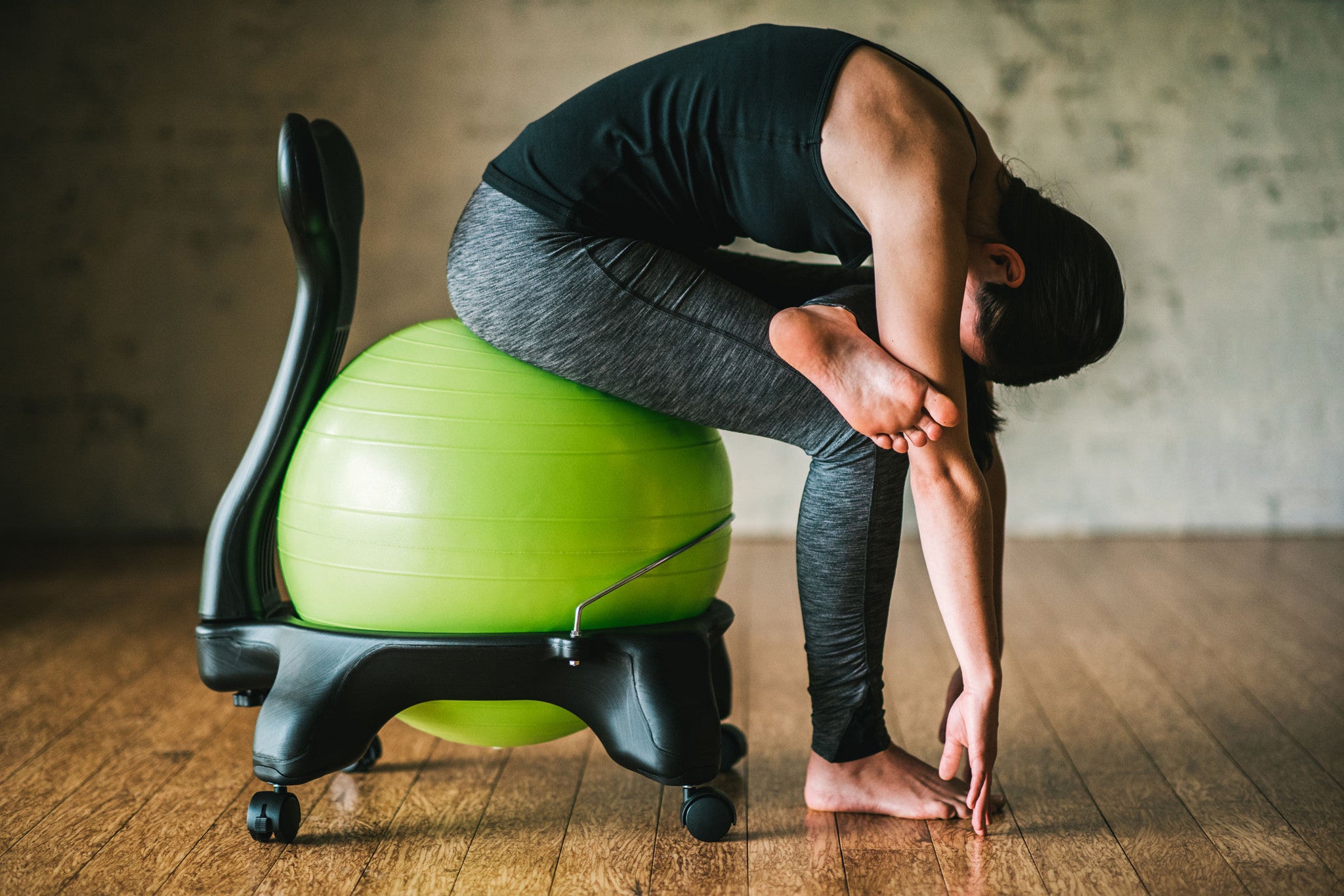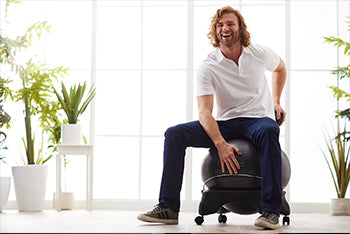3 Stretches for Lower Back Pain without Getting Up from Your Chair

Author: Mary Jo Cameron
Desk work is a real pain in the neck, back, and shoulders…why suffer? Release the tension fast without getting up from your chair with these three chair stretches.
While you can do some of these using a regular office chair, these stretches were chosen by a chiropractor for the exercise guide that comes with the Gaiam Balance Ball Chair featured on Good Morning America and in a Wall Street Journal review of the best office chairs.
First, sit in Positive Seated Posture
You'll begin two of these exercises in Positive Seated Posture. Some of this is just smart ergonomics, regardless of what kind of office chair you have. And if you're using a Balance Ball Chair, this sitting position alone is designed to provide a slew of physical and health benefits:
- Relieve stress on the spine and muscle fatigue throughout the body, especially in the back, neck, hips, and hamstring area.
- Prevent back pain, repetitive motion disorders, and other health issues related to poor posture.
- Tone and strengthen your abs, back and other core (torso) muscles while you sit, because your midsection has to work harder to keep you upright — whereas in a standard office chair the body tends to slump and slouch, leaving the core muscles slack and inactive.
Here's how to sit in Positive Seated Posture position:
- Sit upright with sit bones directly on top-center of chair or ball. Thighs and shins should be at a 90-degree angle to floor.
- If hips are raised higher than knees, lower seat or deflate ball until you achieve a 90-degree angle.
- If hips are lower than knees, raise seat or inflate ball until you achieve a 90-degree angle.
- You can use a foot riser (set it to be level, parallel with the floor) below your desk to help you achieve a 90-degree angle, but do not use the riser during the stretches or exercises; use it only for sitting at your desk.
In proper Positive Seated Posture, the spine should feel long and upright, and you should feel the natural curve in the lower back. Torso should feel completely balanced on the chair, without excess weight on the feet. If your torso is falling forward with excess weight on your feet, you may be seated too far forward. If you don’t feel the natural lower-back curve or feel little or no weight on your feet, you may be seated too far back.
CAUTION: If you're using a Balance Ball Chair, do not lean back against support bar. The bar is designed only for stability during exercises and only as shown in the Desktop Guide that comes with the chair.
Exercise #1: Seated Forward Bend
The numerous benefits of this exercise include releasing tension in the spine, stretching the lower back and hamstring muscles, energizing the brain and central nervous system, and slowing the heart rate. Do this stretch anytime you need to take a quiet break and unwind.
- Begin in Positive Seated Posture (see above).
- Inhale, raising arms overhead.
- Exhale and fold forward from waist, leading with chest and dropping torso to thighs.
- Reach hands to floor, allowing arms to hang relaxed from shoulders.
- Inhale deeply; on exhale, let torso ease further into thighs.
- Keep neck soft and let it drop comfortably from shoulders down between knees. Try not to spread legs apart; keep positive balance between feet and sit bones.
- Relax shoulders, feeling as if shoulder blades are falling down away from neck.
- Hold for 10 long, comfortable breaths; release and repeat two to three times.
You can also do the Seated Forward Bend exercise with your legs extended (not bent at the knee) straight out in front of you or out to the sides at a 45-degree angle.
Exercise #2: Seated Hip Stretch
Many of us spend extended periods of time seated; this can result in tight hips, unbalanced posture and an inefficient stride. This seated stretch initiates a deep stretch of the hip joints, creating flexibility in the knees and buttocks and promoting better posture and a more efficient stride.
- Begin in Positive Seated Posture (see above).
- Fold left leg across right knee. Left ankle should rest just outside right leg.
- Reach tall through spine, keeping neck and shoulders relaxed.
- Maintain balance over waist without losing the natural curve of lower spine.
- Inhale; on exhale, fold forward from waist, leading with chest and dropping torso down to thighs and crossed leg.
- Reach hands down to floor, allowing arms to hang relaxed from shoulders.
- Keep foot flexed. Breathe evenly and comfortably.
- Hold for five long breaths; release and repeat two to three times.
- Repeat on right side.
Exercise #3: Spine Stretch
This exercise is designed specifically for the Gaiam Balance Ball Chair. It would be tough to do this move on a regular office chair (even one without arms), and we don't recommend trying it, since the curve of the ball is what affords the fantastic arch and stretch of the spine in this move.
But it's SUCH a wonderful stretch — as you well know if you've ever done this move using a standard Balance Ball or exercise ball on the floor — that we wanted to include it here.
This stretch helps lengthen and realign the spine, hips and waist. It initiates a deep stretch of the thoracic cavity, opening the chest and increasing lung capacity. It also helps counteract the effects of slouching and hunching of the shoulders.
- Begin by sitting sideways on lower edge of chair.
- Place hands on ball and support bar for stability.
- Lie back over ball, reaching hands and legs out. Keep hands and legs at shoulder-width for stability, feet flat on floor.
- Be sure hips are positioned directly on top of ball. The hips are the centerline of the body for this stretch.
- Breathe deeply, letting torso and legs fall freely from hips and waist.
- Keep shoulders and neck relaxed, reaching long through hands.
- Close your eyes; breathe deeply for a few minutes.
- When ready, slowly curl yourself up to a seated position, resting for a moment before standing up.
You can also do this exercise in reverse, flipping over and placing your abdomen on the ball.
Also in Blog

Body Peace & Personal Empowerment

Yoga for Swimmers: Poses for Strength and Mobility







